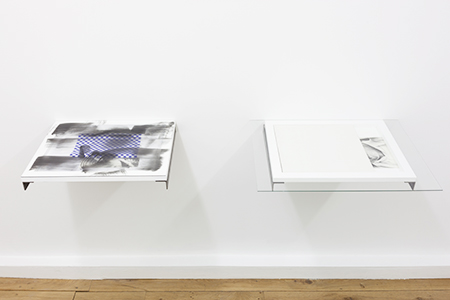Daniel Lipp
Southard Reid, London, UK
Southard Reid, London, UK

What is a screen? On the one hand, it’s a type of partition – an object that separates or hides something. On the other, it is a device that can be used to show rather than conceal (a cinema or TV screen, for example). Daniel Lipp understands this paradox, drawing on it to cultivate a double-life for the screen-like assemblages in ‘Slowmo Drama’ – his second solo exhibition at Southard Reid – pitching them back and forth between guarded privacy and high theatre.
A Hat is Not a Home (2014) comprises two horizontal trays that jut out from the wall at waist height. In the first tray, a small square of fabric printed with a blue check almost totally obscures a black and white image torn from a book. (It possibly depicts a head, but it’s hard to tell.) An enclosing sheet of glass, expressionistically daubed with black printing ink, completes the tray. It’s an object full of brio, though one counterpointed by the stark, but no less dramatic, contents of the adjacent tray: a single white canvas partially covering another black and white image (this time clearly featuring the lower-half of a man’s head). Here, in a nutshell, is the split-screen of Lipp’s work. An ostentatious sculpture that nonetheless remains shy and secretive at its core.
Untitled (2014) is a wall-based box structure composed of three parts: a white powder-coated steel sheath, an inner dibond surface onto which a photocopied image has been transferred and a small piece of couture fabric that dangles loosely from the sculpture’s base. While the fabric, with its imprint of interlocking circles and insouciant positioning, is certainly a curio, the real mystery here is the photocopied image. Cropped from a larger crowd shot, it features two black-clad youths reclining amongst a jumble of surrounding limbs, bodies and heads. Something has caught their attention: they look ahead – both handsome studies in pensive physiognomy. As with Richard Prince’s early re-photography, the magnetism of this image derives from its lack of submissiveness, the way it fails to fully inform us fully of what is going on. Who are these young men? What are they doing? Inscrutability pervades. This effect is redoubled by the frame of encounter: not a photograph, but a sculpture assembled from disparate parts.
Partially concealed by the manic layering of materials, such as packing foam and raw silk, blotted by large circular incisions, pixelated into a blur or simply refused salient context – the adumbration of the male image is a prominent motif running throughout ‘Slowmo Drama’. Whatever it is that the men in this exhibition have to say (for sure it has to do with desire and looking, too), Lipp seems determined to protect it behind a battery of formal devices. This approach is either exhilarating or exhausting; I’m not actually sure. Perhaps it’s just truthful, reflecting the way things often are with desire – that is, far from clear.
To return to the duality of the screen: Lipp’s sculptures (let’s settle on that description, although he makes use of other modes in his work, including painting, printmaking and photography) are elusive. A matter of surface and of superficiality, they nonetheless contain significant hidden depths (particularly in terms of the images they cautiously incorporate). This results in objects that are hard to gauge and even harder to feel impassioned about. That said, ambiguity is doubtless Lipp’s ambition for the work. As an exercise in showing off and hiding at exactly the same time, ‘Slowmo Drama’ should therefore be read, with some circumspection, as an enigmatic success.
























